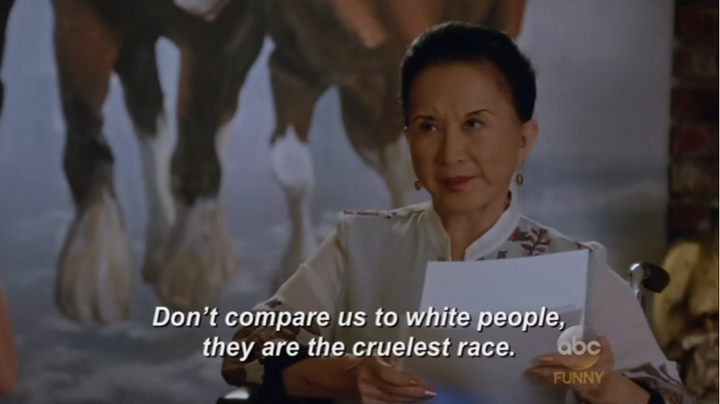
2016 has not been a great year for Asian Americans in the American media. From Chris Rock’s jokes about children of Asian descent at the Oscars, to the whitewashing of a number of characters in popular entertainment (such as Marvel’s The Ancient One, a Tibetan character played by Tilda Swinton, Hollywood’s casting of Scarlett Johansson as a Japanese cyber policewoman in the American adaption of Masamune Shirow’s Ghost in the Shell, and Matt Damon starring as the lead role in a movie called The Great Wall, set in China), Asian Americans haven’t been able to get a break. Bill O’Reilly’s recent segment with journalist Watt Watters, is just another incident in a long list of negative portrayals Asian Americans have had to face this year.
The recent “Watters’ World: Chinatown Edition” opens with O’Reilly stating that China was mentioned about 12 times in the first presidential debate between Donald Trump and Hillary Clinton. O’Reilly points out that the comments about China were mostly negative. The staggering sinophobia is no surprise, for there is a historical record of fear and prejudice against Chinese people and culture in the United States. Beginning with the racist and xenophobic Yellow Peril stereotype which presented Chinese people as backwards, animal-like creatures and the diabolical Fu Manchu image which promoted the belief that the Chinese are sneaky, calculating masterminds obsessed with world domination, the American media has a long history of racist portrayals of the Chinese. These stereotypes, along with the exotifying of Chinese women as stoic and subordinate and the portrayal of Chinese men as quiet and feminine, continue to fill the American media. The fear of Chinese “world domination” is just a continuation of the racist belief that the “barbarian, cold, and calculating” Chinese are out to get the Western world.
Watters, a reporter known for his “street journalism,” went down to Manhattan’s China Town to “sample political opinion.” This may have been a very interesting idea if it was done correctly. It would be interesting to poll Chinese Americans living in New York’s China Town about the portrayal of China in the presidential debate. It would also be interesting to survey China Town residents on their own political beliefs, specifically to see if a neighborhood full of immigrants leans towards a particular political party. Sadly, it seems that Watters traveled to China Town for no other reason than to bother American citizens with racist and xenophobic questions.
Something to keep in mind is that New York City’s China Town is NOT representative of China. Not only is the neighborhood full of American citizens, many may have little connection with the Chinese government. That is because China is a gargantuan country with a largely diverse population. During the Xinhai Revolution of 1911, the Republic of China was founded to unite the five largest ethnic groups of China: the Han, Manchu, Mongols, Hui, and Tibetans. Today, there are 56 officially recognized ethnic groups in China. China is also home to a range of different political identities, with large populations in specific areas such as Xinjiang, Hong Kong, Macau, and Tibet, fighting to separate themselves from China. Factor in the linguistic diversity (Chinese is actually an umbrella term used in English to describe Mandarin, Cantonese, Wu, and a number of distinct languages and dialects) and all of the issues surrounding Taiwan, and you have a humungous group of people who only share one commonality: the West categorize them as “Chinese.”
The larger problem is the segment clearly challenges the American identity of Asian American citizens in Manhattan’s China Town. Frank H. Wu’s Race in America Beyond Black and White defines this idea of Asian Americans as the “perpetual foreigner.” By assuming Chinese Americans have a better relationship with the country of their ancestral heritage, Watters is placing Chinese Americans in a second-class citizen role, unable to fully adopt all the characteristics to become a full citizen of the United States of America. This idea of the “perpetual foreigner” is not limited to Chinese Americans, but a xenophobic image many Asian Americans from a variety of Asian backgrounds must face. Let’s take a more in depth look at the video.
The many pop cultural references made in the interview, from music bites to movie clips, not only lump together many diverse Asian cultures, but also portray the American idea of the “Oriental,” an exotic “other” with mystical, otherworldly power. Carl Douglas’s 1974 song “Everybody was Kung Fu Fighting” plays throughout the video. This song, written by a Jamaican musician and produced by an Indian-British music producer, hardly has any connections with China, aside from its use in popular culture as background music during movie fight scenes and training montages. The pop culture references continue with a clip from the 1984 American film Karate Kid. However, the clip is of Noriyuki Pat Morita, a Japanese American actor, who serves as a mentor to a young Ralph Maccio as he trains in Karate, a Japanese martial art. A further clip of Chris Farley in Beverly Hills Ninja, a movie about an American learning the American portrayal of an ancient martial art of Japan. Watters later asks a resident if he knows Karate. Watters is unaware that Karate is a martial art originating in Japan. The video then cuts to Watters in a Taekwondo studio. Taekwondo is not Chinese, but a Korean martial art. Hanging on the wall of the studio are flags from both South Korea and Hong Kong. It seems that Watters is only perpetuating the image of the Asian as a martial art expert.
Watters’s lack of knowledge of Chinese culture, and how it differs from Chinese American culture is quite astounding. For example, Watters cheekily asks if the Chinese call “Chinese food” just “food.” The answer is way more complicated than Watters expects. Is he asking about Chinese American food, like General Tso’s Chicken? Chinese American food is vastly different than Chinese food (which is, in itself, is a diverse menagerie of culinary dishes). In an attempt to market their food to mainstream American audiences, Chinese American immigrants catered their culinary culture towards the idea of American taste buds, thus creating what Americans incorrectly label “Chinese Food.” For more information on the differences between Chinese American food and Chinese food, please see Ian Cheney’s documentary The Search for General Tso.
Watters’s attempt at “othering” the people he meets continues as he pulls out one racist stereotype after another. Watters awkwardly asks if it is the year of the dragon. He then smiles and asks if, perhaps, it is the year of the rabbit. As he may be poking fun at the Chinese zodiac, he attempts to exotify the Chinese and the Chinese diaspora for believing in something so “mystical.” Ignoring similarities with Western astrological traditions and superstitions, he again attempts to “other” the people he meets in China Town. If only he understood that the ancient tradition of the Chinese zodiac has many modern benefits, including being a polite way to ask for one’s age (Please refer to ShaoLan Hsueh’s excellent Ted Talk for a brief and informative look at the Chinese Zodiac). The segment also shows a clip from the Austin Powers movie, Gold Member, where Japanese twin sisters not-so-cleverly-named Fook Mi and Fook Yu flirt with the British international man of mystery. This racist scene is known for not only playing on the belief that “all Asians look the same” (the actresses who play the twins do not look alike), but also the West’s sexualization of young Asian women. Popularly seen as the epitome of femininity, Asian women are fetishized in Western media, from tales of subordinate Asian women falling for strong American army men, to underage high schoolers Trang Pak and Sun Jin Dinh fighting over the white male football coach in Mean Girls.
Not only is Watters’s attack on the people he meets in China Town grossly racist towards Asians and people of Asian descent, but his xenophobic questions also challenge their “Americanness.” He expects a woman to understand and answer his questions in English. Though the majority of Americans do speak English, the United States does not recognize English as an official language. This notion of “This is America, speak English,” is not only factually incorrect, but also marginalizes the growing number of hardworking English-Learning American immigrants who contribute to the American economy and civic society. In response, The Daily Show sent correspondent Ronny Chieng to Manhattan’s China Town to poll residents in English, Mandarin, and Cantonese. Many of the people Chieng met were not only able to answer his complex questions on the political climate in the U.S., but were also ready to critique their own portrayal in the media. The Daily Show has also released Chieng’s video complete with English subtitles.
This brings me to my final point. O’Reilly and Watters both shared the perception that Chinese Americans isolate themselves from American politics. This is just wrong. There are a number of political organizations in Manhattan’s China Town that push for political empowerment of residents, including the Chinese Consolidated Benevolent Association (CCBA). Manhattan’s China Town is also a historical center for Chinese American politics, as outlined in Peter Kwong’s Chinatown, New York: Labor and Politics, 1930-1950. Though Chinese Americans and other Asian Americans are underrepresented in almost all aspects of American culture, there are a number of American politicians (from Hiram Fong to Nikki Haley), grassroots organizers (such as Yuri Kochiyama), and cultural icons (from Aziz Ansari to George Takei) of Asian descent who have shaped and continue to shape American politics. O’Reilly mentions that the residents Watters meets are “too polite” and “don’t have anything else to do.” Through this comment, O’Reilly is not only continuing the “subordinate Asian” stereotype, but he is spewing the xenophobic rhetoric which has become all too common in the United States. This racist and xenophobic belief is used to describe hard-working Americans from low socioeconomic backgrounds (such as Latinx migrant workers, Native Americans, and Black Americans) as lazy freeloaders working off the hard-earned money of white Middle Class Americans. This, in my opinion, is one of the most dangerous misconceptions in the newscast. The belief that people who do not share your language, religion, or skin color contribute less to society is the fan that feeds the fire of genocide. From the murder of Vincent Chin to the killing of Zhang Chaolin in France, people of Asian descent are facing real violence rooted in these racist and xenophobic terms. These ideas are also one of the cornerstones of Trump’s campaign.
As we slowly get closer to the election, many of us may be wondering how these racist and xenophobic ideas still exist in modern America. As some draw parallels of Trump’s campaign to Hitler’s rise to power, we must remember that America was never perfect. This is, by far, no excuse for the present racism in the states, from the killing of unarmed Black citizens, to the continued genocide of Native Americans. What makes America great is her hope to strive for something better.

